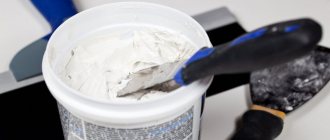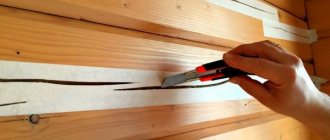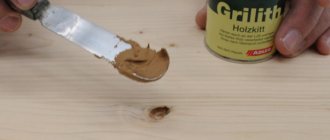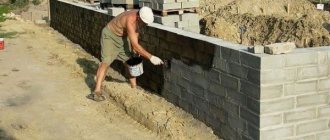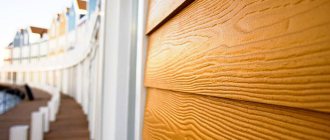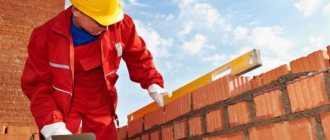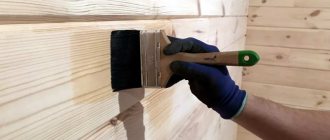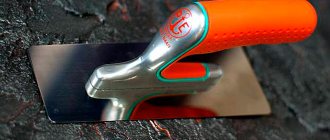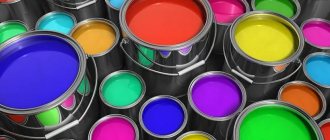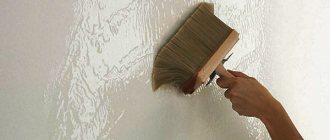Articles
All photos from the article
In this article we will talk about what a wood primer for varnish or paint is, what the composition of these products is and what are the features of their use. The topic of the article is not accidental, since lumber has long been used in the production of furniture and other elements of surroundings, used in construction, etc.
In both cases, the lumber is painted or varnished. Meanwhile, it is well known that before applying paints and varnishes, wood should be properly prepared.
Moisture-proofing treatment of country house walls
Before we find out which deep penetration primer is best for wood, let’s take a closer look at why it is necessary to use these products.
Wood primer: description, types, purpose, application
Professionals know how capricious and high-maintenance wood is.
This natural material needs high-quality protection. Impregnation and antiseptics are usually used. And to change the color of the material, they resort to the use of paints. The main requirement for high-quality application of paint and varnish material is careful preparation of the wood. A high level of adhesion, evenness of the surface and the absence of visible defects are important. The peculiarity of wood is porosity, so paint consumption increases. A wood primer for painting will help improve adhesion and reduce paint consumption. Experienced professionals know how important it is. Although there is an opinion that this stage of tree preparation is optional. Where is the truth, is it necessary to prime wooden walls before painting them? If so, what primer should I choose and how should I apply it correctly?
What is the difference between primer and paint?
There is no need to confuse these concepts. Primer - a composition to improve adhesion and reduce consumption. The paint adheres much better with it. But paint allows you to protect the wood and give it a certain color.
It turns out that the primer is the base layer before applying any decorative material. And paint is a self-sufficient decorative layer. However, many people ask if it is possible to apply primer over paint. Yes, under certain conditions. For example, if the paint layer adheres well to the surface and is not too old. But not all mixtures can be applied over paint, because it creates a smooth surface. An adhesive and non-contact primer is used.
There is such a thing as primer paint. This is a substance that has both a coloring pigment and creates a protective film on the surface. However, as experts recommend, they should not be used. Firstly, the color range is too small, and secondly, the coloring matter in them is of low quality. The product price is low. It is better to prime the wooden surface separately and then apply paint.
What functions does the primer perform?
To determine whether a primer is needed before painting your walls, you need to become familiar with the functions it performs and also know some facts, such as:
Let us note right away that priming a wooden surface is required even if no flaws are visible on it. And if this is repeated decorative treatment, then a number of other preparatory work is also carried out.
The peculiarity of primers for wood is that they ensure adhesion of the finishing paint and varnish material with the coating. Adhesion is the “sticking together” of materials. If adhesion is low, the paint will not adhere tightly and will begin to peel off after a year or two. The appearance after the renovation just done will not be the best. The reason for this is temperature changes, mechanical effects on the surface, and the presence of resin in the structure of the wooden board. If you use a primer before painting the wood, the paint will not peel off.
In rooms with high levels of humidity, poor ventilation or improperly insulated walls, there is a high risk of mold and mildew. Penetrating primer contains special additives called fungicides. Thanks to them, biological microorganisms will not form on the surface. And to protect wood from rotting, a composition with antiseptic properties is selected.
Another positive property of the primer is cost savings. After all, it will take much less paint and varnish material to paint the surface. Consumption is reduced to 25%.
Source
Wood protection products
To prevent the wood from deteriorating, it should be treated with impregnation before coating it with varnish or stain.
You need to choose a product taking into account several factors: operating conditions (indoors or outdoors), temperature conditions and climatic features.
Antiseptics
Water-based antibacterial impregnations prevent the appearance of mold or fungi on wooden surfaces. Antiseptics have a very toxic composition, so it is not recommended to use them on products that are planned to be used in a residential area.
Wood protection productsFire retardants
Such compositions significantly reduce the natural flammability of wood products, and if a fire occurs, they prevent its rapid spread. They are used for surfaces that are located close to fire sources.
Insecticidal compounds
They serve as reliable protection against insects. They are used to treat outdoor wooden surfaces, garden furniture and other items that will be outdoors.
Water-repellent impregnations
They are used to protect wood from swelling when wet, cracking and deformation when drying. Products of this type penetrate deep into the wood, filling the pores of the material, and after final drying they provide a reliable water-repellent layer.
Such impregnations can be used for surfaces of products used in damp rooms and outdoors.
Combined products
Liquids that perform two or more functions, such as preventing insects and mold. They are used in cases where surfaces need to be protected from several potential threats. Consecutive use of several products takes more time and effort, and is more expensive, and combined products in this case are the best choice.
Is it necessary to prime wood for varnish?
It is believed that varnish can protect wood from the negative effects of the environment. However, this composition partially solves this problem.
Wood must be primed in cases where the material is constantly in contact with water or is used in conditions of high humidity. In such situations, varnish is not able to prevent the development of mold or rotting.
However, not only such problems are solved by the primer.
Purpose and properties of soil
Treating wood with a primer has several purposes:
It is necessary to prime wood in the following cases:
It is recommended to prime all types of wood, regardless of the characteristics of the latter.
Pros and cons of applying a primer coat
Applying a primer layer under varnish has the following advantages:
The disadvantages of surface priming include the following:
What kind of primer mixture is needed?
Having visited the construction market, slightly confused by the variety of goods offered there, a non-professional sometimes succumbs to the persuasion of sellers who advertise their product as universal, and may make a mistake with the purchase. To prevent this from happening, you need to decide before going to the market why and for what purpose the primer will be purchased. Its composition largely depends on this.
The purposes of applying primer can be the following:
- smoothing out uneven surfaces before applying varnish;
- restoration of old parquet or wooden floors;
- the desire to emphasize the texture of wood, to brighten its pattern;
- increase the shade of panels or parquet;
- protect the product from the risk of darkening;
- increase the resistance of parquet to wear;
- protect wood from unfavorable environmental conditions, fungi, rot - this most often applies to wooden products for outdoor use: gazebos, terraces.
Which primer is suitable?
Due to the fact that different types of primer are applied under the varnish, when choosing this material the following circumstances must be taken into account:
It is also recommended to pay attention to the composition of the primer mixture. If the material contains harmful substances, finishing work should be carried out outdoors.
Varieties by composition
The types of varnish primers according to their composition are summarized in the table below.
| Type of mixture | Characteristics |
| Acrylic | The composition penetrates deeply into the structure of the wood, completely saturating the material. Acrylic primer is used for painting with any mixtures. This product is odorless, dries within 1-4 hours and is used for interior work. Water is used to change the viscosity of acrylic primer. |
| Silicone-acrylic | Silicone, which is part of the mixture, increases the hydrophobic properties of the soil. Thanks to this material, it is possible to process wood used in damp areas. A surface finished with such soil stops absorbing moisture. |
| Alkyd | Such mixtures are used when the surface is subsequently treated with alkyd dyes. Such compositions dry within 12-18 hours. Alkyd primer can also be applied to a painted surface. Mixtures containing colored pigments form a matte layer after drying. |
| Polyvinyl acetate | This type of soil dries within 30 minutes. To increase adhesion, it is recommended to apply a thin layer of PVA glue after treatment. |
| Polyurethane | This is the most expensive type of primer for varnish. In such mixtures, solvents in different concentrations are used. Also, the primer does not contain pigments. |
| Shellac | This mixture is used to level a wooden surface. Shellac primers close natural pores, thereby preventing resin from escaping. The mixture also creates an insulating layer, so the composition can be applied to raw materials. |
By properties and purpose
Primers used for varnish finishing are also divided into the following types:
The type of primer is always indicated on the container with the mixture.
Kinds
There are several types of alkyd varnishes.
Two-pack
They consist of two components, the second component being a desiccant. Before application, the mixture must be combined into one composition in the ratio specified by the manufacturer. After this you can start painting. Typically, a durable and high-quality coating requires surface treatment in 2 or 3 layers.
An important feature of such compositions is the short shelf life of the finished mixture - the solution is suitable for use for 8 hours. According to their characteristics, the compositions are characterized by the highest performance
However, the varnish has a pungent odor, as well as low resistance to sunlight.
Alkyd-urethane
It becomes popular due to the characteristics of the mixture in which alkyds react with polyurethane. The mixture is improved due to a special component - toluene diisocyanate, thanks to which the varnish drying process is carried out slightly differently. First of all, the solvent evaporates, and after that the mixture solidifies when exposed to oxygen. The drying time of the surface with this drying mechanism is reduced, in addition, the resistance to abrasion, temperature influences and high humidity improves.
However, due to the fact that half of the alkyd-urethane varnish consists of an organic solvent, its toxicity increases. The products are also unsafe in terms of fire, so the operation of coatings requires additional safety measures. In addition, if the coating does not dry completely, and the base is already in use, situations are inevitable in which the varnish is deformed, forming serious defects. They can only be removed with a grinder.
Matte and glossy
The compositions differ only in what texture the dried base has after processing. The matte composition forms a more practical surface, since dirt and marks are less visible on it; there are also semi-matte mixtures. Gloss is best used in rooms with minimal lighting, as it reflects light perfectly. In terms of the set of components, both products do not differ at all, which is why the choice of mixture will be based only on the taste preferences of the consumer.
Yacht
Based on the name, the scope of use of the product becomes clear - the mixture is produced for coating wooden yachts, but in addition to treating ships, such a specialized composition can be used on substrates that are used in humid microclimates
However, please note that yacht varnish can only be used for exterior use.
This limitation is explained by the chemical composition of the material - to increase moisture resistance during the production of varnish, toxins, for example, toluene, are included in its main set of required elements.
For metal
In its composition, it is a mixture of alkyds and polymers. The substances provide metal substrates with shine and an attractive appearance. The mixture has high resistance to chemically aggressive substances, high humidity, thermal effects on the surface, in addition, adhesion to various types of material makes it possible to use the varnish indoors and outdoors.
To achieve high quality results, it is better to use products from one manufacturer. Alkyd compositions for parquet can be classified as follows:
- Water-based mixtures. The advantage of the solutions is the absence of odor and environmental friendliness of the product. But such paints and varnishes are expensive.
- Two-component varnishes.
- One-component compositions.
Based on the type of coating, alkyd varnishes are divided into the following subtypes:
- glossy;
- matte;
- semi-gloss;
- semi-matte.
Rating of the best brands
The presented rating is based on user reviews collected on the Internet. The primer grades indicated in the list are not suitable for all wood operating conditions.
Belinka Base
This soil provides protection against:
Such characteristics led to a high price: 5 liters of Belika Base cost more than 2.6 thousand rubles.
Biofa 3754
A universal mixture used for treating uneven surfaces and types of wood (mainly coniferous species), which absorb applied compounds well. This material is recommended for exterior and interior decoration. Biofa 3754 does not contain solvents, which allows the mixture to be used in conditions with poor ventilation. A 1-liter container of such primer costs about 1 thousand rubles.
Tikkurila Euro Primer
A primer, or deep penetration primer, of a Finnish brand is used for finishing external surfaces. The material contains components that give the mixture antibacterial and disinfecting properties. Despite these characteristics, 3 liters of this primer cost 400 rubles.
This brand produces primer mixtures intended for treating porous surfaces. Such compositions can be used for:
Tex brand soils have the following features:
Tex brand primers penetrate deep into the wood structure, binding the fibers. Thanks to this effect, the indicated results are achieved.
If the wood is affected by fungus or mold
If such a problem occurs, universal remedies are no longer useless. It is necessary to individually select the drug for “treatment”, taking into account the type and degree of damage to the walls.
Wood can be classified according to the degree of damage:
- Slightly affected. Mold is just beginning to take over the space. In such cases, ordinary antiseptic impregnations, especially those based on water dispersion, can sometimes be effective.
- Heavily infected. Here, if it is not possible to replace the damaged area of the wall, floor, or ceiling, it should be cleaned and then antifungal agents or anti-mold agents should be used.
When dealing with wood, you should not neglect such a necessary thing as a primer with antibacterial properties.
Properly selected in accordance with the operating conditions and the nature of the surface (board, unbarked log, beam), the drug is able to penetrate deeply into the material, increasing its resistance to adverse environmental conditions, temperature changes, fungi and rot, significantly leveling the walls, and ensuring subsequent good adhesion of the decorative coating with the base, providing high-quality repairs.
Processing rules
Primers are applied in the same way as paint and varnish coatings. However, in this case it is necessary to take into account a number of nuances that have a direct impact on the quality of the dried layer.
Material consumption
The primer consumption is indicated on the packaging and depends on various factors: application conditions, type of surface to be treated and others. On average, when processing a square meter of surface, up to 80-120 milliliters of protective material are used.
Required Tools
The type of tools for priming wood is also selected based on the work conditions. To apply the material, you can use a sprayer, roller or brush. It is also recommended to purchase tools and devices for cleaning surfaces from defects.
Surface preparation
Before priming the wood surface you must:
If there are greasy stains on the surface, it is recommended to treat such areas with a soap solution. Old paint should also be removed before priming the wood.
Acrylic compounds should be used as putty, which, after drying, retain the same elasticity and do not crack if the size of the processed material changes.
Applying a layer
Despite the fact that primers are produced in ready-made form, it is recommended to carefully place the composition before application. After prolonged storage, sediment appears at the bottom of the container. You should work at temperatures from +5 to +30 degrees.
Over old paint
It is possible to prime wood over old paint if the type of previously applied material matches the protective mixture. But before starting work, it is recommended to remove loose pieces and treat the surface with sandpaper. This will increase the adhesion of the wood and speed up the finishing process.
If the shade of the old paint and varnish do not match, the surface must be primed in 2 layers. Further work can be carried out after the protective composition has completely dried. If the old paint differs in characteristics from the new one (for example, alkyd was previously used, but now oil is applied), then first the surface should be heated with a construction hairdryer. After this, you need to remove any remaining material, using a solvent if necessary.
If the soil does not contain substances that prevent the formation of mold, the wood should be treated with an antiseptic before applying the mixture.
On fresh wood
The primer can be immediately applied to fresh wood after preparing the surface. In this case, there is no need to carry out any other work.
Drying time and further work
The drying time depends on the type of primer and work conditions. The protective material gains strength within 0.5-18 hours. At temperatures above +25 degrees this process takes less time. After priming, the wood can be treated with varnish or other finishing materials.
Oil impregnations
Such substances have been used for a long time and their effectiveness is confirmed by ancient estates of the 18th-19th centuries, in which the floors are in perfect condition to this day. At that time, they did not yet know about varnish for wooden floors, but drying oil, hemp or linseed oil were actively used.
The surface of the boards was additionally rubbed with wax, which made it possible not to maintain the coating, but to protect it from stress for a period of 10-12 years. Some might say that more than a dozen years have passed between the 18th century and our time. The fact is that it is the applied substances that function for 10-12 years, and then they are simply cleaned off, the flooring is sanded and the oil and wax treatment procedure is repeated. It is worth noting that even in ordinary military barracks of that time, pine floors were used for at least 50-70 years without replacement.
Advantages of using oils when processing pine boards:
- the oil is more stable when used in rooms with poor heating and large temperature changes (for example, a country house);
- the oil penetrates deep into the structure of the board, thereby creating a moisture-protective layer that prevents warping of the wood;
- after processing the board, it can even be used outdoors and under intense exposure to moisture, which has been proven in practice when creating ships from pine boards;
- Unlike the composition of some paints and varnishes for pine floors, oil impregnations do not change the structure of the wood and preserve its naturalness. Therefore, pine boards can be used even in specialized institutions (hospitals, kindergartens).
Natural and synthetic oils presented on the modern building materials market are very good at processing wood and create reliable protection against the penetration of moisture and air through the coatings, but oil is not able to create surface protection against wear, so additional treatment of the boardwalk with wax is necessary.
Also, wax can be contained in the composition of the oil impregnation used, and then during processing an outer layer will be created, which will significantly increase the durability of the coating and maintain its presentability for a very long period of time. Typically, either natural wax is used, or a synthetic alternative based on polyurethane is added to the impregnation.
It is important to remember that paint or varnish for the floorboard cannot be used if it has previously been treated with oils or wax. To carry out such work, you will have to remove a significant layer of wood (at least 2 millimeters), but even this does not give a guaranteed result, and therefore there is a risk that the adhesion of the applied paint to the surface will be very poor
When choosing oil impregnations, it is very important to choose a material from a reliable manufacturer. You should not skimp on this component to keep the coating in excellent shape. For example, they are highly valued for their quality: the Finnish brand “Caparol”, the German “Alpina”, the Dutch “Pinotex”, etc.
All of them produce various painting materials, primers, impregnations and other products for working with flooring.
For example, they are highly valued for their quality: the Finnish brand “Caparol”, the German “Alpina”, the Dutch “Pinotex”, etc. All of them produce various painting materials, primers, impregnations and other products for working with flooring.
When working with several substances at the same time, it is best to purchase materials from one manufacturer to ensure the closest possible interaction. The prices for such products on the domestic construction market are not the highest, since the companies listed above have production facilities in Russia.
Primer on wood before painting with varnish - the best means
Primer for wood under varnish - features of use and properties
So, we invite you to find out what a primer for wood under varnish or painting is, what the composition of such products is and what the features of use are. The chosen topic of the article is not accidental, because lumber has long been used for the production of furniture and other surrounding elements, and is also used in construction.
In both the first and second cases, the lumber is painted or coated with a varnish composition. Meanwhile, it is well known that before applying paints and varnishes, the wood must be properly prepared.
Before we find out which specific deep penetration primer is best suited for wood, let’s take a closer look at what causes the need to use the product.
How to polish the varnish after painting a car?
During initial deep polishing
use a coarse abrasive paste, then switch to a fine abrasive one and finally use a paste without abrasive.
For cars
of dark colors, the use of a non-abrasive paste after finishing polishing is mandatory, since flaws
in the painting
and varnishing are visible on their surface.
Interesting materials:
Where to plant Catharanthus? Where to plant cedar in the country? Where to plant cedar in the garden plot? Where to plant cedar on the site? Where to plant coleus in the garden? Where to plant a vine? Where to plant daylilies in the garden? Where to plant daylilies in the country? Where to plant a raspberry tree? Where to plant juniper in the country?
Primer tasks
You need to prime the wood to create a protective film on its surface. It will increase the practicality of the base and extend its service life.
Protective functions are especially important for external work where, without additional protection, the surface of the wood will be especially susceptible to corrosion, rotting, excessive dampness, mold and other troubles.
Since solid wood costs money, every effort must be made to extend its service life and protect it from negative external influences. But this is not the only function of priming.
There are a number of wooden surfaces that must be pre-primed:
Varieties by composition
When choosing a composition, you should take into account not only the protective and toxic qualities of the primer, but also the characteristics of the varnish that will be applied after this, at the final stage of work.
Types of primer based on base material:
- Alkyd is most liked by professional builders and is considered the best. The wood treated with it dries for up to 18 hours, a matte, dense protective film is formed on its surface, which emphasizes the structure. This primer is non-toxic. Using it, you can significantly increase the wear resistance of parquet or plank wooden floors.
- Water-dispersion and its version - acrylic - dry quickly. They are odorless and non-toxic. Wood treated with this composition is easily sanded and protected from rot and mold.
- Shellac. More often used for processing damp or poorly dried wood, it consists of methyl alcohol and the milky juice of insects. Has pronounced protective properties.
Before priming
In order for the wood, first coated with a primer and then varnish, to look impressive and last a long time, it must be properly prepared and stocked with the necessary tools.
Tools you will need:
Having stocked up on tools, you can begin the preparatory work. All wooden surfaces are treated with sandpaper, smoothly moving it along the wood fibers. It is necessary to gradually change the grain size from coarse to finer. To process large areas (such as parquet, panels), it is more convenient to wrap a bar of the required size with abrasive paper; for smaller parts (furniture elements), it is more convenient to wrap a rubber plate.
Tip: It is most convenient to collect fine dust and wood shavings with a vacuum cleaner. After thoroughly processing and cleaning the surface, you can begin to apply the primer layer.
How to prime correctly
The surface of the parquet, floor, door, panels, furniture has already been carefully leveled, cleaned of dust and debris, dried, now you can proceed to the intermediate stage before applying varnish - priming.
- First you need to pour the solution into a convenient container. When using a concentrate, dilute it with water or solvent according to the instructions.
- It is necessary to prime evenly, using, depending on the surface, a roller or a brush. Apply the solution to the surface along the wood fibers.
- After the first layer of primer has dried, it is necessary to “sand” the wood fibers to a smooth surface; if necessary (when restoring old parquet, panels), use wood putty.
- Apply another 1-2 layers of composition on top.
- After complete drying, you can proceed to the finishing stage: coat the product with tinted or colorless varnish.
It is important not to skimp on primer. A few extra layers of coating improve the quality of the finish and allow you to achieve the desired effect.
After priming is completed and the last layer has completely dried, the wood is coated with tinted or clear varnish 2-3 times. The finishing coat must be applied in a very thin layer, without drips or streaks.
Compliance with the correct technology at all stages: preparation, priming, varnishing can guarantee that a wooden floor, door, parquet will retain its original appearance for a long time, will delight with its warm, artistically emphasized texture, creating a cozy atmosphere in the house.
General information
The first thing that interests home craftsmen when they are faced with a similar task is whether it is possible to paint with paint over varnish? Of course, it is best to remove the old coating, but if this is not possible, or you need to save time, then you can paint over the old coating.
True, in order to say with confidence whether it is possible to apply paint to varnish, it is necessary to clarify what kind of paint and varnish material we are talking about. The fact is that not all compositions are suitable for these purposes. For example, you cannot use nitro paint, as the old coating will begin to peel off over time.
In addition, before applying the coloring composition, the surface still needs to be prepared in a certain way.
Faktura
This antiseptic creates a decorative layer under valuable wood species, protects external and internal surfaces made of any wood. Not suitable for use on floors.
This varnish can be treated with an antiseptic without prior priming. It is used in dry and very damp areas including bathrooms and kitchens. A single layer coating is enough to provide complete protection and create a decorative layer. Faktura does not turn yellow or fade over time and protects products from cracking. You can apply this varnish in rooms for children and medical institutions.
Conclusion
Now we have a general idea of how and why we need to prepare lumber for subsequent painting. As a result, you can purchase one or another primer and prepare your wooden cottage or summer house for painting work.
More useful information can be found by watching the video in this article.
Applying varnish to wooden surfaces will increase the service life of furniture, parquet and other products. This preserves the texture of the wood and prevents discoloration and fading of the paint.
Preliminary stage: Preparing the wooden surface by tinting.
To give the wood the desired color and improve the texture, before applying varnish . Next, the surface is sanded with a grain of at least P100 (in accordance with the FEPA standard).
Do wooden doors need to be primed before painting?
At the preparatory stage of work, the door leaf must be treated with a polyurethane or acrylic primer. We do not recommend using water-based liquids. This can lead to deformation of the door geometry and swelling of their surface.
Interesting materials:
How to dilute chlorophyllipt for mouth rinse? How to breed compound feed? How to dilute copper sulfate for processing tomatoes? How to breed Normobact entero? How to dilute hydrogen peroxide for nasal rinsing? How to propagate fresh yeast? How to dilute Agromax fertilizer? How to dilute leaf gelatin? How to dilute iron sulfate for wood processing? How is iron sulfate diluted?
Application technology
Any wood must be cleaned of dirt and dust, and, if necessary, the top layer must be sanded. Then you need to prepare the primer composition. It needs to be stirred, since standing for a long time may cause a small but solid sediment to form at the bottom of the jar.
The more uniform the primer is, the better the application result will be.
Remove dust from the surface with a damp sponge, and remove greasy stains with a soap solution. Minor defects are repaired with putty, and old paintwork is completely removed.
Any of the following tools will be suitable for application.
It is better to prime at positive temperatures and low air humidity. Each applied layer is given sufficient time to dry.
The application technology is the same for all types of wood, but the preparation is different.
Over old paint
If you plan to prime old wood that has already been painted and the type of paint matches the type of primer, there is no need to completely strip off the old paint.
Alkyd, oil paint, nitro enamel must be removed with sandpaper. It is important to ensure the roughness of the top layer of the base. If there are areas with loose wood fibers, they need to be removed with a spatula and sanded.
If the colors of the old and new paint do not match, a separating layer of primer must be applied between them. The dye must be applied after the primer has completely dried. If the new type of finish differs from the old one in properties, for example, it was alkyd paint, but is covered with oil paint, you need to heat the painted surface with a hair dryer. Afterwards, the remnants of the old paint are removed with a metal spatula. If there are still traces of the old dye, they need to be wiped off with a solvent.
Next, the surface is treated with an antiseptic and a finishing primer for painting. An antiseptic can be either a separate additive to the soil or be part of a universal primer.
On fresh wood
Fresh wood is sanded and scraped. Then the cracks and minor defects are sealed with acrylic putty. It does not crack when the size of the tree changes due to its high elasticity.
You need to remove any remaining dust and dirt from the surface, and then start priming. The acrylic mixture will need to be applied in several layers.
Why is parquet primer used?
Untreated parquet wears out faster, so it is necessary to prime the coating. Do I need to prime before applying gypsum plasterboard? Application of the composition before final finishing provides the following results:
- High-quality varnishing of lamellas. The primer levels out the parquet, filling cracks and closing pores.
- The correct composition emphasizes the natural shade and texture of the wood, preventing darkening and drying out of the lamellas.
- Even if the varnish gets between the slats, the lamellas will not stick together, which means that the risk of deformation is reduced and when replacing dies locally, you will not have to lift the entire base.
- If a primer is used for parquet, varnish consumption is significantly reduced.
- After priming, a protective film is formed on the surface, preventing the formation of mold and rot.
Primers for adhesive clean parquet from dust, level the surface, and serve as a good waterproofing and impregnating agent. Varnish compositions are used to increase the strength of the coating, increase wear resistance, protect against stains, loss of color and well prepare the coating for final varnishing.
Useful tips
Air humidity should be low. This will allow the material to dry faster. The air temperature should be from 5 to 30 degrees above zero. The higher it is, the faster the primer will dry. Therefore, you should do this in the morning or evening.
Old paint
Old paint can be removed by heating it with a hair dryer. It can be removed with a spatula. And using acetone, you can get rid of paint residues. If the new paint is the same type as the old one, then it can be applied without getting rid of the old layer. This does not apply to cases where the paint has begun to deteriorate or peel. This is exactly how wood should be primed. Even if the tree does not need treatment or protection, a primer coat will help save money.
What to consider when choosing a primer
- Place for priming work. If priming doors or other surfaces is done outdoors, you need a façade primer for exterior work. Compositions for interior work are used only indoors. If the composition is chosen incorrectly, the manufacturer does not guarantee a high-quality result of its application.
- Microclimatic characteristics. There are primers that can withstand dry climates, sudden temperature changes, and hot or humid air. A separate mixture is selected for each condition. In very damp rooms, you can use soils with maximum hydrophobic effect.
- Drying time. For each type of soil, the manufacturer indicates its drying time for the applied layer in the instructions. To make it dry faster, in hot weather it is better to prime in the morning or afternoon. In the open air the drying process is accelerated. Alkyd primer dries faster than others.
- Material for subsequent application. If you plan to prime wood for varnish, choose transparent mixtures. Varnishing will highlight the natural color of natural wood. If the primer is being applied for painting, choose a white mixture. It will reveal the richness and fullness of the dye. The white background makes the colors more expressive.
Wood primer brands
Manufacturers offer various types of primer for plastering, wallpaper, painting or varnishing.
Tikkurila Euro Primer
This is a universal wood primer for exterior use. It contains disinfecting and antibacterial additives.
Can also be used indoors.
The cost of a 3-liter jar of soil is 400 rubles.
Biofa 3754
This is a universal hard primer that can be used to treat uneven or highly absorbent surfaces. These include coniferous wood, including pine and spruce.
The range includes mixtures of antiseptics for external use, internal use, and solvent-free primers.
The cost of a kilogram jar is 990 rubles.
Belinka Base
Protective primer for exterior use. It prevents rotting, molding, and damage to wood by woodworms. This is a high-quality and expensive composition. Wood protective primer Belinka Base costs 2,665 rubles. for 5 l.
This is a primer composition for impregnating plasterboard, wood and other porous materials that need to be coated with water-dispersed paints, ceramic finishes and wallpaper. Tex can be used in rooms with normal and high humidity. The primer reduces dye consumption, increases the adhesive properties of the material, and dries quickly. Odorless, fire- and explosion-proof. Strengthens the treated surface. The manufacturer offers a large catalog of soils of this brand with high penetrating ability.
Source
Materials and tools
To impregnate wood products you will need:
- primer;
- cuvette for solution;
- roller or brush (large brush);
- brush - for treating small or complex areas.
All this can be replaced by one sprayer.
Flow calculation
The required amount of primer is calculated using the same method as the need for paint:
- the processing area is determined;
- consumption per 1 m2 is multiplied by the area, and then by the number of layers;
- the result obtained is divided by the weight of the canister or bucket and rounded up.
On hard wood species (oak, beech, white acacia, hornbeam, boxwood, etc.) generally 1 layer is applied, on the rest - 2, on chipboard and other porous materials - 3. If we take the type of impregnation, then the consumption for the first layer :
- for alkyd primer - 130 g/m2;
- acrylic - 120-150 g/m2;
- silicone - 200-250 g/m2;
- epoxy - about 100 g/m2;
- shellac-based solution - 200 g/m2.
